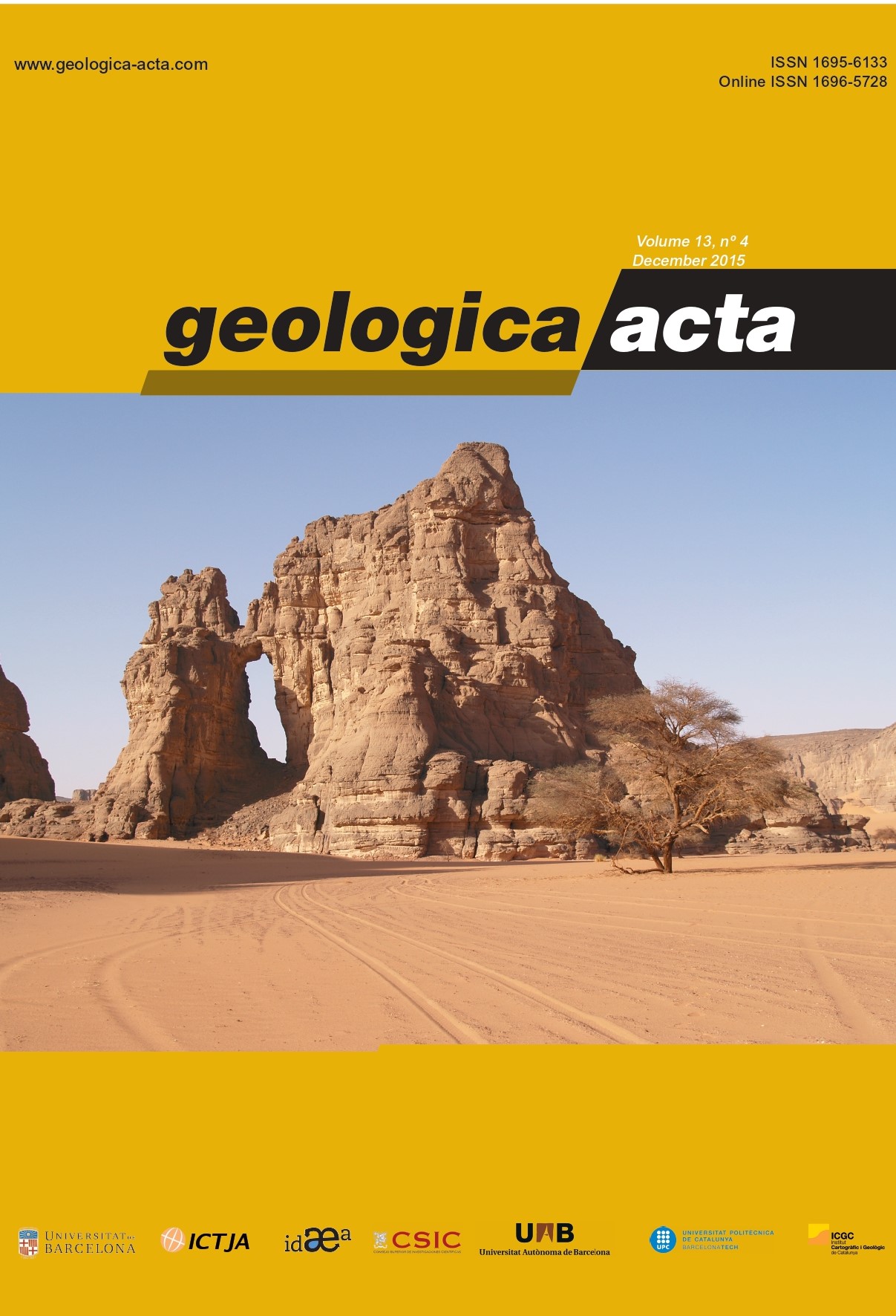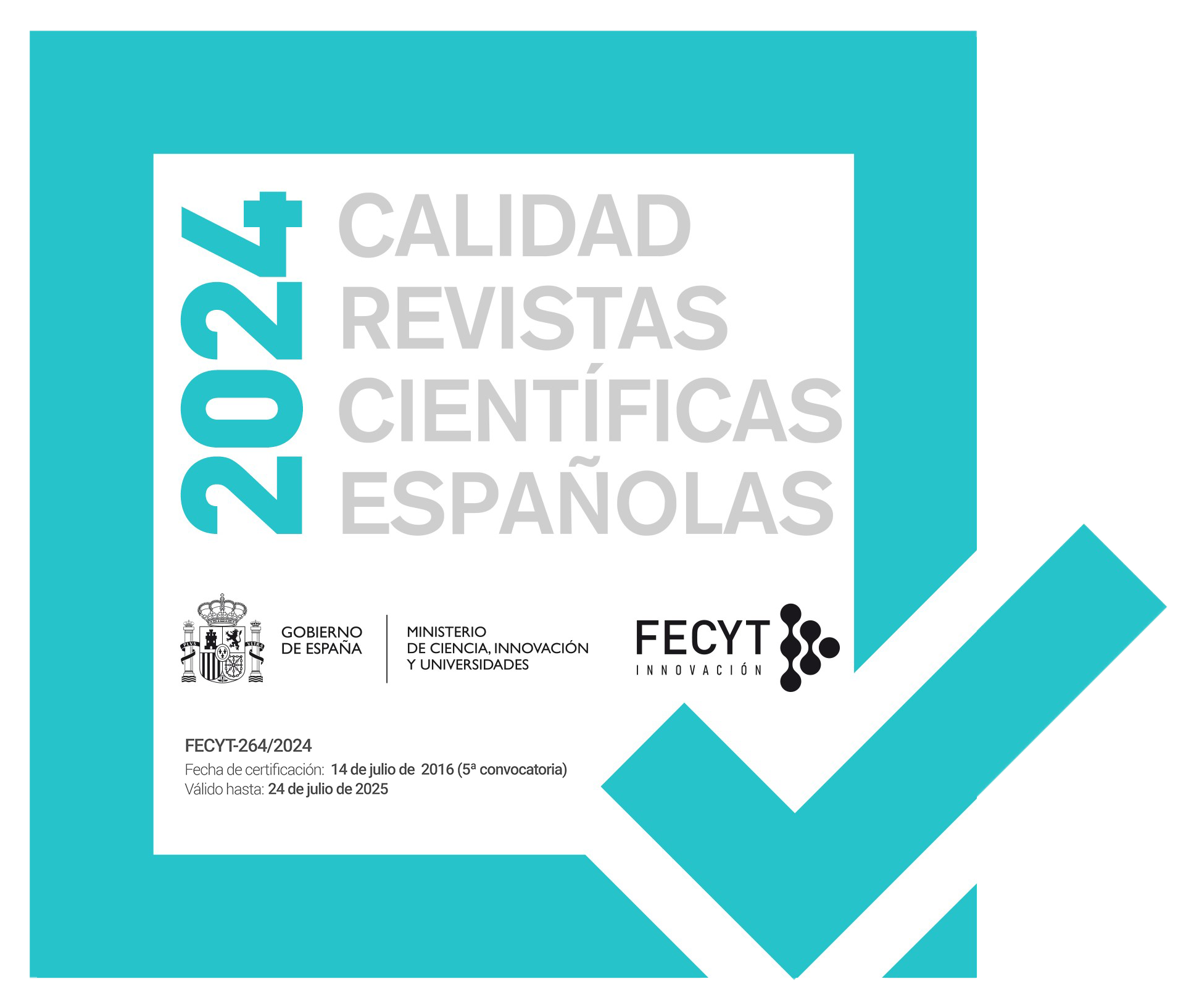A new Devonian asteroid-like ophiuroid from Spain
DOI:
https://doi.org/10.1344/GeologicaActa2015.13.4.6Keywords:
Ophiuroidea, Echinodermata, Devonian, Spain, PhylogenyAbstract
A Lochkovian (Early Devonian) ophiuroid (Echinodermata), Ophiocantabria elegans n. gen. and sp., is based on a single small, well-preserved specimen collected from a shale-rich horizon of the Furada Formation, Asturias, Spain. Sedimentologic and palaeontologic data suggest its occurrence was in a near-shore setting subjected to frequent storms. Ophiocantabria is assigned to the Encrinasteridae based on the morphology of individual skeletal elements, although overall form of the new species is similar to that of approximately coeval members of the asteroid family Xenasteridae. Such homoplasy, especially among earlier members of asterozoan class-level clades, is an important but not well understood aspect of subphylum evolution.
References
Agassiz, L., 1835. Prodrome d’une monographie des Radiaires ou Echinodermes. Mémoires de la Société des Sciences Naturelles de Neuchâtel, 1, 168-199.
Blake, D.B., 2007. Two Late Ordovician asteroids (Echinodermata) with characters suggestive of early ophiuroids. Journal of Paleontology, 81, 1486-1495.
Blake, D.B., 2013. Early asterozoan (Echinodermata) diversification: A paleontologic quandary. Journal of Paleontology, 87, 353-372.
Blake, D.B., Guensburg, T.E., 2015. The class Somasteroidea (Echinodermata): Morphology and Occurrence. Journal of Paleontology, 89, xx–xx.
Brouwer, S.A., 1964. Deux faciès dans le Dévonien des Montagnes Cantabriques Méridionales. Breviora Geológica Asturica, 8, 3-10.
Chauvel, J., Meléndez, B., 1978. Les Echinodermes (Cystoïdes, Astérozoaires, Homalozoaires) de l’Ordovicien moyen des Monts de Tolède (Espagne). Estudios Geológicos, 34, 75-87.
Forbes, E., 1849. Protaster sedgwickii. Memoirs of the Geological Survey of the United Kingdom. Figures and Descriptions iIlustrative of British Organic Remains, Decade 1, pl. 4, figs. 1-4.
García-Alcalde, J.L., 2011. Los primeros terebratúlidos (Braquiópodos) del Devónico de la Cordillera Cantábrica (N de España). Trabajos de Geología, Universidad de Oviedo, 31, 26-47.
García-Alcalde, J.L., 2013. Terebratúlidos (Braquiópodos) del Devónico de la Cordillera Cantábrica (N de España). Trabajos de Geología, Universidad de Oviedo. 33, 17-170.
García-Alcalde, J.L., Arbizu, M., García-López, S., Leyva, F., Montesinos, R., Soto, F., Truyols-Massoni, M., 1990. Devonian stage boundaries (Lochkovian/Pragian, Pragian/Emsian, and Eifelian/Givetian) in the Cantabric región (NW Spain). Neues Jahrbuch für Geologie und Paläontologie Abhandlungen, 180, 177-207.
García-Alcalde, J.L., Carls, P., Pardo Alonso, M.V., Sanz López, J., Soto, F., Truyols- Massoni, M., Valenzuela-Ríos, J.I., 2002. Devonian. In: Gibbons, W., Moreno, T. (eds.). The Geology of Spain. London, Geological Society, 67-91.
Gorzelak, P., Salamon, M. A., Lach, R., Loba, M., Ferré, B., 2014. Microlens arrays in the complex visual system of Cretaceous echinoderms. Nature Communications, 5, article number: 3576. DOI: 10.1038/ncomms4576 (2014)
Gray, J.E., 1840. A synopsis of the genera and species of the class Hypostoma (Asterias Linnaeus). The Annals and Magazine of Natural History, 6, 275-290.
Gregory, J.W., 1897. On the classification of the Palaeozoic echinoderms of the group Ophiuroidea. Proceedings of the Zoological Society of London for 1896, 1028-1044.
Haeckel, E.H., 1866. Generelle Morphologie der Organismen. Zweiter Band: Allgemeine Entwicklungsgeschichte der Organismen. Berlin, Verlag von Georg Reimer, 160pp.
Hammann, W., Schmincke, S., 1986. Depositional environment and systematic of a new ophiuroid, Taeniaster ibericus n. sp. from the Middle Ordovician of Spain. Neues Jahrbuch für
Geologie und Paläontologie Abhandlungen, 173, 47-74.
Harper, J.A., Morris, R.W., 1978. A new encrinasterid ophiuroid from the Conemaugh Group (Pennsylvanian) of Western Pennsylvania, and revision of the Encrinasteridae. Journal of
Paleontology, 52, 155-163.
Haude, R., 1995. Echinodermen aus dem Unter-Devon der argentinischen Präkordillere. Abhandlungen, Neues Jahrbuch für Geologie und Paläontologie, 197, 37-86.
Haude, R., 1999. Der - verzogerte - Ersatz eines Homonyms: Marginaster Haude 1995. Abhandlungen, Neues Jahrbuch für Geologie und Paläontologie, 1999, 292-294.
Jangoux, M., 1982. Food and feeding mechanisms: Asteroidea. In: Jangoux, M., Lawrence, J.M. (eds.). Echinoderm Nutrition. Rotterdam, A.A. Balkema, 117-160.
Jell, P.A., Theron, J.N., 1999. Early Devonian echinoderms from South Africa. Memoirs of the Queensland Museum, 43, 115-199.
Kesling, R.V., 1964. A drastic reappraisal of «Lepidasterella babcocki Schuchert»—as Helianthaster gyalinus Clarke, a streptophiuran auluroid. Contributions from The Museum of
Paleontology, The University of Michigan, 19, 115-133.
Matsumoto, H., 1915. A new classification of the Ophiuroidea with descriptions of new genera and species. Proceedings of the Academy of Natural Sciences of Philadelphia, 67, 43-92.
Museum of New Zealand Te Papa, July 2015. Website: http://collections.tepapa.govt.nz/object/1372777
Paterson, G.L.J., Baker, A.N., 1988. A revision of the genus Ophiambix (Echinodermata: Ophiuroidea) including the description of a new species. Journal of Natural History, 22, 1579-1590.
Schöndorf, F., 1910a. Paläozoische Seesterne Deutschlands. II. Die Aspidosomatiden des deutschen Unterdevon. Palaeontographica, 57, 1-65.
Schöndorf, F. 1910b. Über einige «Ophiuriden und Asteriden» des englischen Silur und ihre Bedeutung für die Systematik paläozoischer Seesterne. Jahrbüchern des Nassauischen Vereins für Naturkunde in Wiesbaden, 63, 206-256.
Schuchert, C., 1914. Stelleroidea Palaeozoica. Fossilium Catalogus I: Animalia 3, 53 pp.
Schuchert, C., 1915. Revision of Paleozoic Stelleroidea with special reference to North American Asteroidea. United States National Museum, 88(Bulletin), 311pp.
Shackleton, J.D., 2005. Skeletal homologies, phylogeny and classification of the earliest asterozoan echinoderms. Journal of Systematic Palaeontology, 3, 29-114.
Simonovitsh, S. 1871. Ueber einige Asterioiden der rheinischen Grauwake. Sitzber. math.-natur- wiss. CI. Akad. Wiss.,64 (I, 7), 77ñ122.
Smith, A.B., 1984. Ophiuroidea (Asterozoa) from the Lower Llanvirn of the Toledo Mountains (Central Spain). In: Gutiérrez-Marco, J.C., Chauvel, J., Meléndez, B., Smith, A.B. (eds.). Los equinodermos (Cystoidea, Homalozoa, Stelleroidea, Crinoidea) del Paleozoico inferior de los Montes de Toledo y Sierra Morena (España). Estudios Geológicos, 40, 421-453.
Sollas, W.J., Sollas, I.B.J., 1912. Lapworthura: a typical brittlestar of Silurian age; with suggestions for a new classification of the Ophiuroidea. Philosophical Transactions of the Royal Society of London, 202B, 213–232.
Spencer, W.K., 1914. The British Palaeozoic Asterozoa. Palaeontographical Society of London Monograph, Pt 1. 1-56.
Spencer, W.K., 1930. The British Palaeozoic Asterozoa. Palaeontographical Society of London Monograph, Pt.8. 389-436.
Spencer, W.K., 1951. Early Palaeozoic starfish. London, Philosophical Transactions of the Royal Society, B. 235, 87-129.
Spencer, W.K., Wright, C.W., 1966. Asterozoans. In: Moore, R.C. (ed.). Treatise on Invertebrate Paleontology, Pt. U, Echinodermata 3(1). Lawrence, The Geological Society of America and The University of Kansas, U4-U107.
Stürtz, B., 1886. Beitrag zur Kenntniss palaeozoischer Seesterne. Palaeontographica, 32,75-98.
Stürtz, B., 1890. Neuer Beitrag zur Kenntniss palaeozoischer Seesterne. Palaeontographica, 36, 203-247.
Swofford, D.L., 1998. PAUP*. Phylogenetic Analysis Using Parsimony (*And Other methods). Version 4. Sinauer Associates, Sunderland, Massachusetts.
Downloads
Published
Issue
Section
License

This work is licensed under a Creative Commons Attribution-ShareAlike 4.0 International License.
Copyright
Geologica Acta is the property of the UB, GEO3BCN, IDAEA and UAB. Geologica Acta must be cited for any partial or full reproduction. Papers are distributed under the Attribution-Share Alike Creative Commons License. This license allows anyone to reproduce and disseminate the content of the journal and even make derivative works crediting authorship and provenance and distributing possible derivative works under the same or an equivalent license.
Author Rights
Authors retain the copyright on their papers and are authorized to post them on their own web pages or institutional repositories. The copyright was retained by the journal from the year 2003 until 2009. In all cases, the complete citation and a link to the Digital Object Identifier (DOI) of the article must be included.
The authors can use excerpts or reproduce illustrations of their papers in other works without prior permission from Geologica Acta provided the source of the paper including the complete citation is fully acknowledged.




